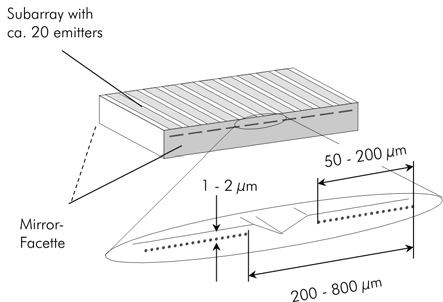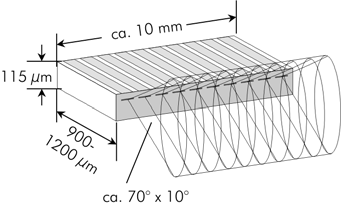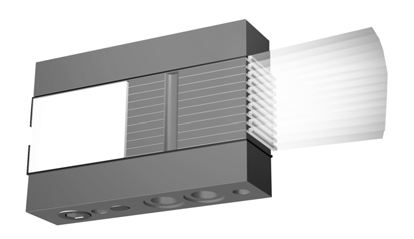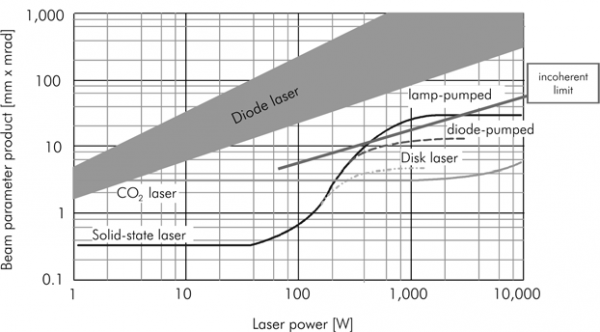An Introduction to Diode Laser
Laser diodes are well known for their applications in the area of communication technology, computer engineering, and entertainment electronics. These applications are based primarily on laser beam sources with powers in the milliwatt range. For some years, high-power diode lasers, with a power rating of up to several kilowatts, have been available. With these lasers – given certain limitations due to the attainable beam quality and energy density on the workpiece – machining tasks may be solved at moderate expense. In addition, high-power diode lasers, due to their special characteristics, can even open up new applications that were once considered unattractive or even impossible for lasers.
Diode laser bars
Laser light with a power of several mW can be produced in a very thin and narrow zone (with a typical emitting area sized approx. 1 µm x 1 µm) by recombining the electron-hole pairs in a special semiconductor structure (based on GaAs). A variety of these elements may be combined in a semiconductor element to construct a laser bar approximately 10000 µm x 1200 µm x 115 µm. A typical emitting surface area consists of about 20 fields with approx. 25 single emitters each (Figure below). These single emitters of a field may also be combined to form a strip (wide-strip laser)

The laser resonator is formed by two fracture surfaces of the bar. The bars are coated to achieve the desired reflection properties, normally to a length of 900 – 1200 µm. The emitted laser radiation shows high divergence in the direction of the pn transition (“fast axis“) and, in the far field, has a Gaussian profile. In the direction parallel to the plane of the pn transition (“slow axis“), the radiation exits in the far field as a superposition product of the individual emitter groups (Fig. below).

Typical data of a cooled diode laser bar are summarized in the following table:
Cooling technology for diode laser bars
Despite the high electro-optical efficiency of up to 50 %, an efficient cooling system is needed to attain output powers without risking thermal damage to the laser bars.
The laser bar is soldered to a ”micro-channel“ where the heat sinks by a special technique requiring µm precision in all three dimensions.
These soldering processes must be performed in a clean room, due to the open semiconductor structure.
Today’s high-power diode lasers primarily use micro-channel heat sinks made of copper with special coatings. These are favored for the heat conduction properties.
Beam forming by micro lenses
The highly divergent radiation, oriented perpendicularly to the pn transition in the semiconductor, may be collimated by cylindrical micro-lenses that are positioned very close to the bar (Figure below). The micro-lenses are attached with a precision in the µm range.

High-power lasers
Power increases can be created with the combination of several diode laser bars installed on heat sinks (see Figure below). This arrangement is referred to as a “stack“. Today it is technically feasible to stack approximately 30 individual elements on top of each other, achieving a total stack power far in excess of 1 kW.

By using suitable geometrical and optical arrangements, various stacks may be optically combined. This makes it possible to construct high-power diode lasers with a maximum output power of up to 3.1 kW, which are now commercially available as standard products. To increase the power without compromising on the beam quality, stacks must be combined in a way that the emitting surface remains constant, while making sure that each combined stack uses the same optical path.
A combination method, in conjunction with the stacking technique, is based on the principle of filling up non-radiating areas of a stack to the area of the micro-channel cooler with radiation from another one. In addition, various different wavelengths may be superimposed along one optical path by corresponding mirrors. A third alternative, which is used on an industrial level today, is the coupling of two differently polarized beams along one optical path.
The radiation from a diode laser, using cylindrical and spherical optical systems, is focused on a square spot of several mm2. The laser head, the housing unit of the very small beam source and the optical imaging system, together with a main supply unit and a cooler, forms a highly complex laser system. The laser head is approximately the size of a shoebox and weighs approximately 10 kg.
Demanding beam transformation concepts are needed to adapt the different divergences and, under certain conditions, to further improve the beam quality in relation to the simple square spot. Examples include the ”step mirror“ or beam tilt unit. These specialized optical elements are used to split the wide laser beam (along the “slow axis“) into smaller sections and arrange these at various levels on top of each other, so that width and divergence along one (the “slow“) axis are reduced at the expense of the other (the “fast“) axis.
Beam quality of diode lasers
The non-circular, astigmatic, incoherent beam generated by a high-power diode laser makes it difficult to measure the beam parameters and to compare them to those of conventional lasers. Despite these difficulties, a comparison will be attempted, based on certain assumptions. Thus, by definition, the average beam parameter product is the geometric mean of the fast and the slow axis.
This approach makes it possible to reveal the application potential of diode lasers as well as their limitations.
The graph (Figure below) compares the beam quality, in relation to the laser power, of various laser types and illustrates that commercially available diode lasers today have a relatively low beam quality compared to established CO2 and solid-state lasers. This is due to the non-coherent coupling of the individual emitter groups (up to many thousands in number) and to the astigmatism of the emitter groups resp. of the laser bars.

Ambitious research projects, however, have proven considerable enhancements of the beam quality in high-power diode lasers; this new laser technology may very well conquer new areas of applications in the future. Despite this, it is very unlikely that diode lasers will be utilized soon for beam parameter product ranges that are now the exclusive domain of CO2 lasers and solid-state lasers. The system efficiency would be inadequate for such concepts; and financial feasibility would be all too hazardous in competition with other laser beam sources. Thus, it is not to be expected that laser cutting with diode lasers will establish itself in the industrial marketplace.
